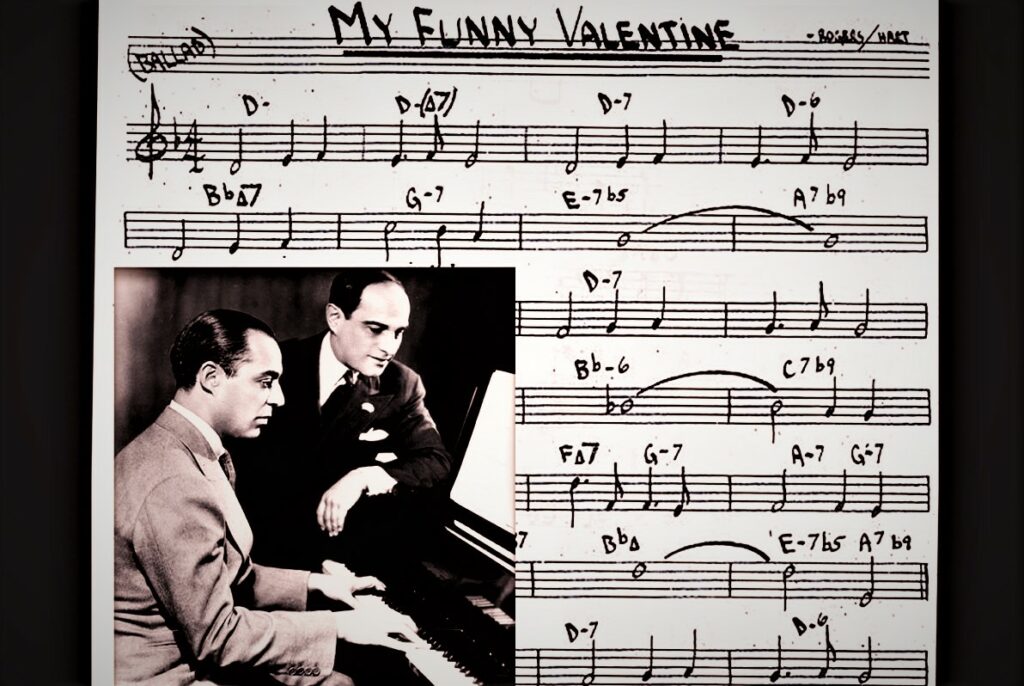For Valentine’s Day, a journey into the life of this beloved standard written for the 1937 Broadway show Babes in Arms
If there is a better and more lasting song for this holiday, none are more famous or beloved. It was written by Richard Rodgers—one of the greatest melodists of his generation—and his first songwriting partner, the legendary lyricist Lorenz “Larry” Hart.
Videos by American Songwriter
Created in 1937 for the show Babes in Arms, it’s a standard of the greatest multitude, with 1073 known recordings at this moment, and included on thousands of different albums. There’s a vast range of recordings of it by great singers, recording artists of every generation, bands, and a melange of other luminaries, lounge-singers, movie & TV stars and millions of others. It’s one of those songs which everybody wants to sing at some point, and most of them seem to have recorded it.
The very first singer to do so was Mitzi Green, who starred in Babes In Arms on Broadway, where she delivered the song’s debut on opening night, April 14, 1937. It was an instant standard in some ways, in that many recordings came almost immediately.

The song reflects the distinct characters of Rodgers and Hart. Not unlike words and music themselves, they were quite different, yet could unite their singularities into timeless, remarkable songs.
“My Funny Valentine” is a perfect example of those merged singularities. Rodgers brings the timeless, romantic music, sophisticated yet romantically infectious, replete with aching melodic leaps known to tug human heartstrings, as on the word ‘smile’ in its second line, “…you make me smile in my heart…”
Yet Larry Hart, not unlike Randy Newman (who is Rodgers to his own Hart), delighted in dimensional human songs that reveal the realities of real people, replete with real human failings. Hart wrote what can be considered an “I love you anyway” love song lyric; rather than idealize the beloved, it does the very opposite, even specifying their foibles and fumbles, yet concluded with a declaration of love. As if to say, I love you – in spite of all the things you are.
The result is a genuine song about the reality of human love: that true love endures even when romance becomes reality. To love each other despite all our earthbound constraints is a testament of true love.

The title tells you straight away that there’s something funny about this valentine. In its opening, this situation is clearly delineated immediately.
My funny valentine, sweet comic valentine
You make me smile in my heart
Not swoon, or lust in the heart, Smile. It’s about lifting one’s spirits more than lighting the fire of passion.Because ultimately in life, though passion plays a starring role, more lasting can be learning to laugh, instead of cry, at all life is bound to bring.
Then comes the appearance of the beloved, which is somewhat extreme:
Your looks are laughable, unphotographable
Yet you’re my favorite work of art
Yes, Stephen Sondheim has famously criticized Larry Hart for this lyric, because, according to Sondheim, nobody is ‘unphotographable’ except a vampire or ghost.
Yet except Sondheim, who applies this kind of criticism to his own lyrics which he feels fail in the light of his his intense Sondheimian scrutiny (such as his lyric for “I feel Pretty” from West Side Story, which he feels is too rhymey for a character with little education), few have ever quarreled with the meaning of Hart’s words. It’s isn’t literal. This isn’t Dickens, it’s popular song.

But in that acceptance of one’s beloved as human, in addition to that beautiful tune, is the heart of this Valentine song.
The song does have what was called then a verse – an introductory section of words and music which leads directly to the chorus, and is not repeated. Even the most famous recordings of the song skip over it, and go straight to the famous opening section.
That rarely-heard verse is:
“Behold the way our fine feathered friend
His virtue doth parade
Thou knowest not, my dim-witted friend
The picture thou hast made
Thy vacant brow, and thy tousled hair
Conceal thy good intent
Thou noble upright truthful sincere
And slightly dopey gent“
The lyric is great – especialy built around that simple yet perfect title. But the lyric alone would not matter if not for the great Rodgers melody. That greatness is affirmed by the untold number of instrumental versions of it, includsing those by Miles Davis, Bill Evans, Chet Baker, Gerry Mulligan and Chucho Valdez.
It’s a melody both inspired and ingenious, empowered by that famous ascension all through “Is your figure less than Greek?/Is your mouth a little weak?/When you open it to speak, are you smart?”
Rodgers and Hart met in 1919. Larry Hart was 24 years old, seven years older than Rodgers, who was 16. Yet they each were gifted as songwriters in their separate roles: Hart the wordsmith and Rodgers the composer, and shared the passion for music and songwriting. Both were from Jewish families (Hart’s name was originally Hertz; Rodgers was Rojazinski).
Hart was already a drinker by then, and Rodgers became one. Rodgers lived the more traditional life, married to the same woman from youth to old age. Hart was gay, though closeted officially, but the sorrow at keeping his heart forever secret lived always in the dualities of his lyrics. Such as this one. He died at the age of 38 in 1943, as the second World War was being waged.
Rodgers outlived Hart and also his replacement as lyricist, Oscar Hammerstein. He lived to the age of 77 in 1979, and continued writing musicals to the end. In 1965 he wrote Do I Hear A Waltz with Stephen Sondheim (who had no interest in doing a musical in which he didn’t compose the music also. He did that with Leonard Bernstein for West Side Story, which launched his career. After that he wanted to write both words and music – and famously did for decades. , but made an exception when asked to work with Richard Rodgers.

The song has been performed and recorded by the greatest and most beloved singers and musicians of the day – and all following days – including Frank Sinatra, Judy Garland, Ella Fitzgerald, Duke Ellington, Al Viola, Sarah Vaughan, Billie Holiday, Carmen McRae, Shirley Bassey, Perry Como, Sammy Davis, Jr, Johnny Mathis, Dinah Shore, Tony Bennett, Harpo Marx, Jackie Gleason, Red Skelton, Frankie Valli, Stan Getz, Chet Baker, Barbra Streisand, Lena Horne, Marvin Gaye, Julie Andrews, The Supremes, Nico, Linda Ronstadt, Steve Goodman, Carly Simon, Van Morrison, Anita Baker, Etta James, Chaka Khan, Elvis Costello, Shirley Horn, Judy Collins, Merv Griffin, Don Grusin, Leon Russell, Leon Ware, Jerry Jeff Walker, Sam Smith, and many thousands of others.
As a companion piece to this, we will share with you both our favorites and the funniest ones. My personal favorites include several, starting with Rickie Lee Jones rendition on her great Girl at Her Volcano record. She sings it – as she sings every song she’s recorded, whether her own or not – with such genuine heart and soul that it brings out every aspect of this gem. It’s triumphant, romantic, funny, sorrowful and more timeless than the most timeless songs.
But everything Rickie Lee sings – to me – is gold (including the moon – serious Rickie fans will get the reference).
There’s also the haunting versions by Chet Baker and Billie Holiday, who – like Rickie Lee – sing it with a “smile and a tear,” to quote Toots Thielemans about music that marries sorrow and joy.
There’s also Harpo Marx’s sweet instrumental version – the man was a fine harpist as well as the last great silent movie star (his name, incidentally, was pronounced by his brothers with no R; Hah-po.)
That one, and a few other favorites, are here as our Happy Valentine’s card for you.
